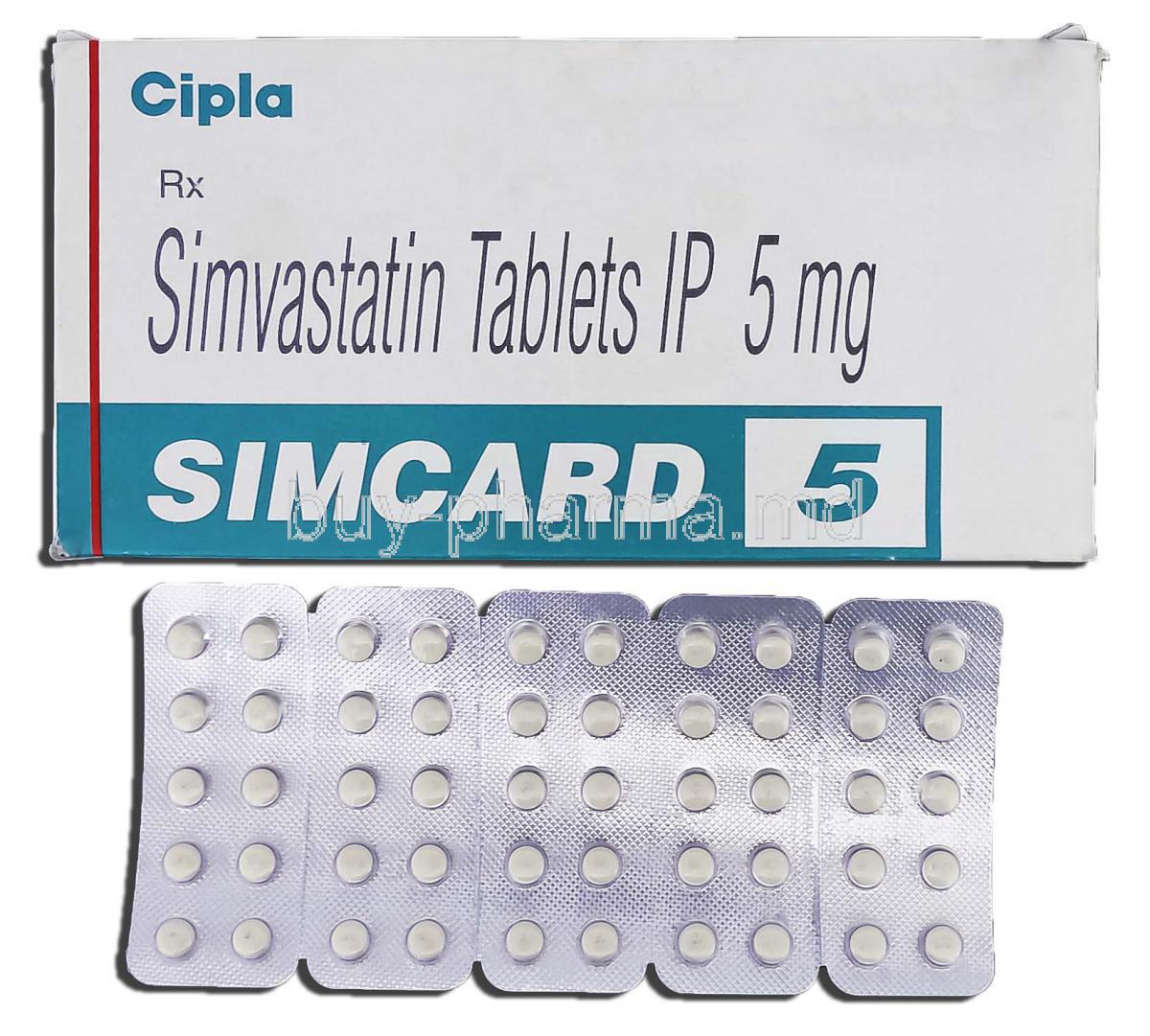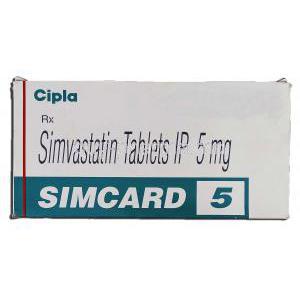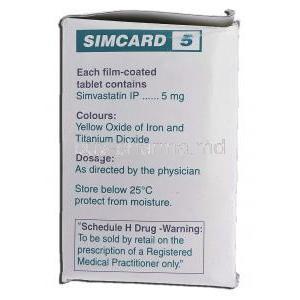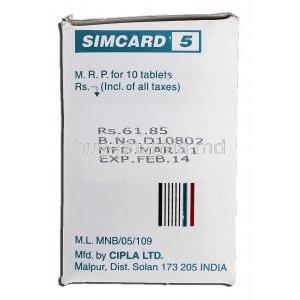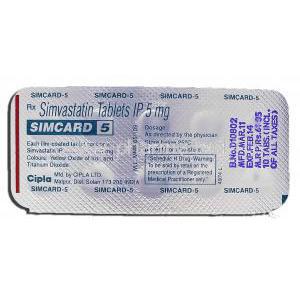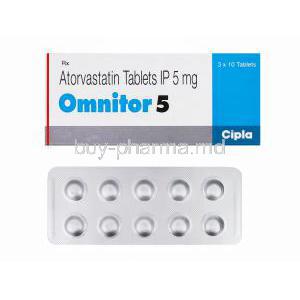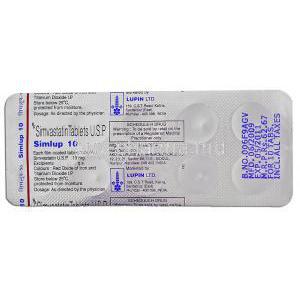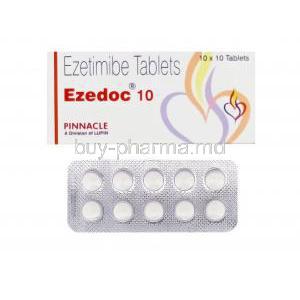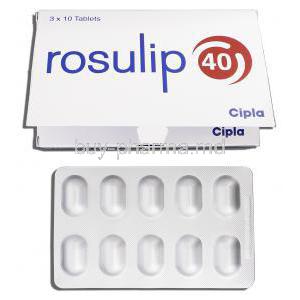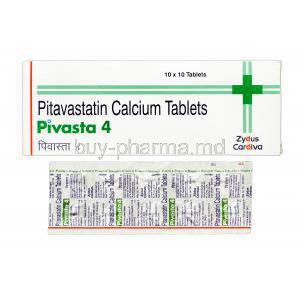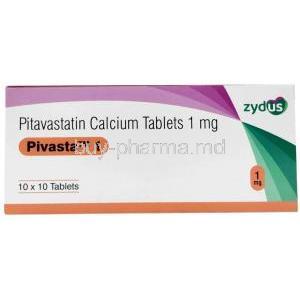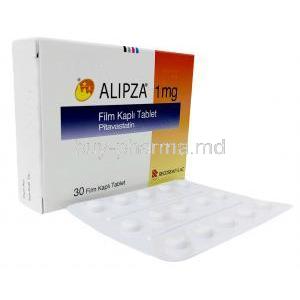Simcard, Simvastatin
- Introduction to Simcard (Simvastatin)
- Composition and Active Ingredients
- How Simcard (Simvastatin) Works
- Approved Medical Uses of Simcard (Simvastatin)
- Off-Label Uses of Simcard (Simvastatin)
- Dosage and Administration Guidelines
- Simvastatin dosage ranges for cholesterol management
- Starting dose recommendations based on lipid profile and risk factors
- Max dose limits and safety considerations
- Administration timing (evening dosing for optimal effect)
- Dose adjustments for patients with renal or hepatic impairment
- Missed dose instructions
- Side Effects of Simvastatin
- Common Side Effects
- Simvastatin Interactions
- Warnings and Important Precautions
- Risk of myopathy and rhabdomyolysis
- Monitoring of liver function tests before and during therapy
- Risks associated with combining simvastatin with high-dose niacin
- Precautions for patients with alcohol misuse or liver disease
- Importance of reporting unexplained muscle pain or weakness
- Simvastatin side effects after stopping
- Simvastatin alternatives
- Contraindications
- Careful Administration Guidelines
- Overdosage and Emergency Management
- Storage and Handling Precautions
Introduction to Simcard (Simvastatin)
Overview of Simcard brand and generic name Simvastatin
Simcard is a pharmaceutical preparation containing Simvastatin, a widely prescribed lipid-lowering agent. Belonging to the statin family, this medication is primarily indicated for reducing harmful cholesterol levels and supporting cardiovascular health.
Historical background and approval timeline
Simvastatin emerged in the late 20th century as a pivotal development in cardiovascular pharmacotherapy. Approved by regulatory authorities worldwide, it quickly became an essential therapy in preventive cardiology due to its capacity to lower cardiovascular morbidity and mortality.
Therapeutic classification: HMG-CoA reductase inhibitor (statin class)
Simcard belongs to the HMG-CoA reductase inhibitor category, commonly known as statins. This group of drugs revolutionized lipid management by directly targeting cholesterol biosynthesis in the liver.
Importance of cholesterol management in cardiovascular health
Controlling serum lipids is crucial for mitigating risks associated with atherosclerosis, heart attacks, and cerebrovascular accidents. By lowering low-density lipoprotein (LDL) and triglycerides while enhancing protective high-density lipoprotein (HDL), Simcard contributes to long-term vascular protection.
Composition and Active Ingredients
Active ingredient: Simvastatin
The core therapeutic agent is Simvastatin, responsible for the cholesterol-lowering effects.
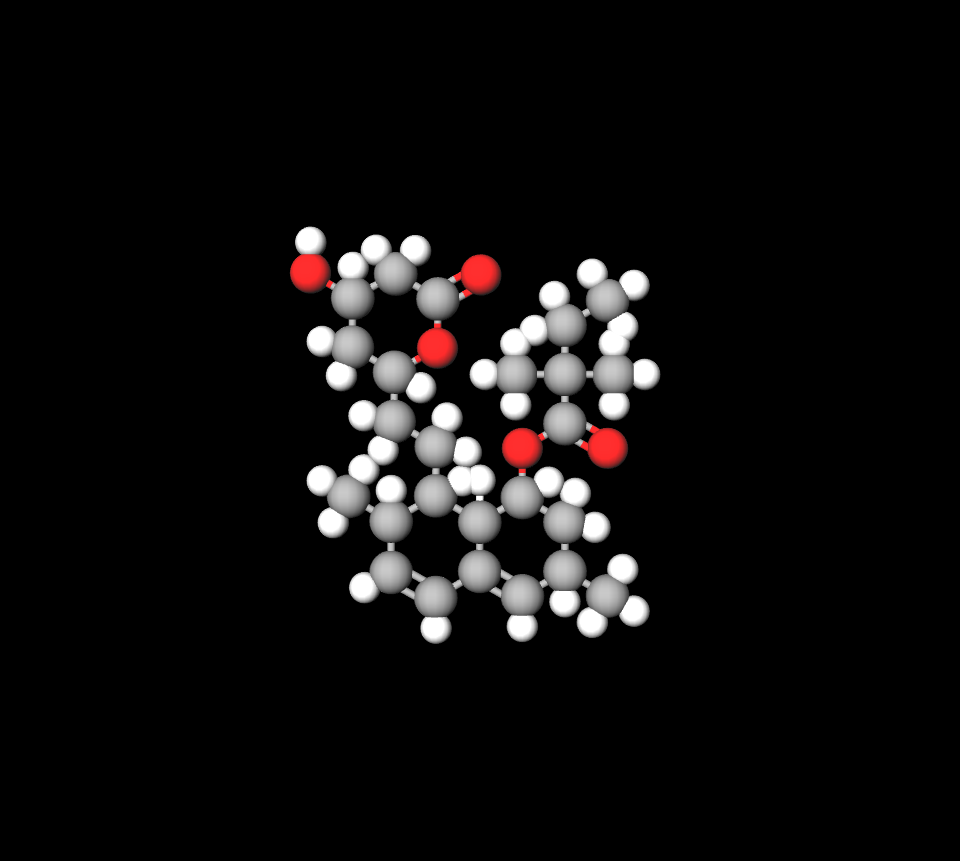
Available strengths and dosage forms (tablets, capsules)
Tablets available in multiple strengths (5 mg, 10 mg, 20 mg, 40 mg, 80 mg)
- Formulations designed for once-daily oral administration
Inactive ingredients and excipients
Simcard formulations often contain excipients such as lactose monohydrate, microcrystalline cellulose, magnesium stearate, and starch. These compounds enhance stability, absorption, and tablet integrity.
Differences between branded Simcard and generic simvastatin formulations
While the active ingredient remains identical, minor variations in excipients and manufacturing processes may influence tolerability or absorption. Both branded and generic options are considered therapeutically equivalent.
Amlodipine and simvastatin
When used in combination, amlodipine can raise simvastatin levels in your bloodstream. This may result in an increased risk of statin-related side effects, such as muscle damage.
Ezetimibe and simvastatin
Ezetimibe/simvastatin is a medication combination used to treat dyslipidemia. This pairing of Simvastatin and Ezetimibe enables simultaneous inhibition of both cholesterol production and absorption.
Simvastatin and paxlovid
Combining Simvastatin and paxlovid can notably raise the blood levels of simvastatin. This may heighten the risk of side effects like liver damage and a rare but serious condition known as rhabdomyolysis, which involves the breakdown of skeletal muscle tissue.
Simvastatin vs atorvastatin
Simvastatin is classified as a low-to-moderate intensity statin, whereas Atorvastatin (Lipitor) is seen as a moderate-to-high intensity statin. This indicates that Atorvastatin can reduce cholesterol levels more efficiently at specific doses.
Rosuvastatin vs simvastatin
Statins typically are very similar to one another, but rosuvastatin is a bit of an outlier. Rosuvastatin, aside from Lipitor (atorvastatin), is the most potent statin for lowering LDL. It's different than simvastatin and many other statins in several important ways.
Simvastatin vs lipitor
Simvastatin (Zocor) is considered a low-to-moderate intensity statin, while Atorvastatin (Lipitor) is a moderate-to-high intensity statin, meaning Atorvastatin can lower cholesterol more effectively at certain doses.
Pravastatin vs simvastatin
Both are similarly effective as low- or moderate-intensity statins. But neither pravastatin or simvastatin are high-intensity statins. Pravastatin and simvastatin have similar side effects and risks to keep in mind. However, simvastatin interacts with more medications and foods than pravastatin.
How Simcard (Simvastatin) Works
Simvastatin Mechanism of action: inhibition of HMG-CoA reductase
Simcard acts by selectively inhibiting 3-hydroxy-3-methylglutaryl-coenzyme A (HMG-CoA) reductase, a critical enzyme in the cholesterol biosynthetic pathway.
Reduction of LDL cholesterol and triglycerides
The drug significantly lowers LDL cholesterol and triglyceride concentrations, reducing atherogenic particles in circulation.
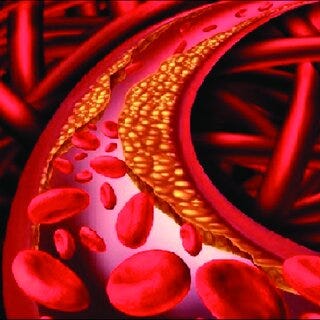
Increase in HDL cholesterol
Simcard modestly elevates HDL cholesterol, providing additional cardioprotective benefits.
Role in plaque stabilization and prevention of atherosclerosis
Beyond lipid lowering, Simcard stabilizes arterial plaques, preventing rupture and reducing thrombotic events.

Impact on overall cardiovascular risk reduction
These combined effects culminate in a reduced risk of myocardial infarction, stroke, and peripheral vascular complications.
Approved Medical Uses of Simcard (Simvastatin)
- Primary hypercholesterolemia: reducing elevated LDL levels.
- Mixed dyslipidemia: controlling cholesterol and triglycerides concurrently.
- Familial hypercholesterolemia: effective in both heterozygous and homozygous cases.
- Prevention of cardiovascular disease: in patients with multiple risk factors.
- Secondary prevention: after myocardial infarction, stroke, or revascularization procedures.
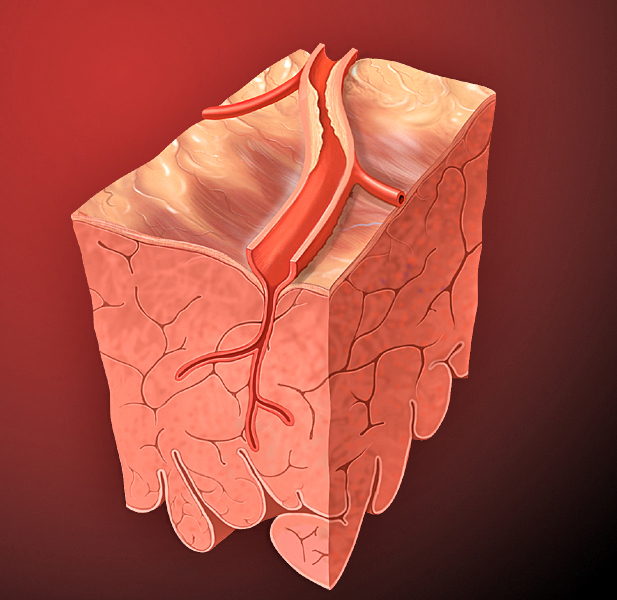
Off-Label Uses of Simcard (Simvastatin)
- Alzheimer's disease: research suggests possible cognitive benefits.
- Anti-inflammatory activity: studied in autoimmune conditions.
- Chronic kidney disease: potential renal-protective effects in diabetics.
- Venous thromboembolism prevention: ongoing trials evaluate effectiveness.
- Cancer adjunct therapy: exploring anti-proliferative potential.
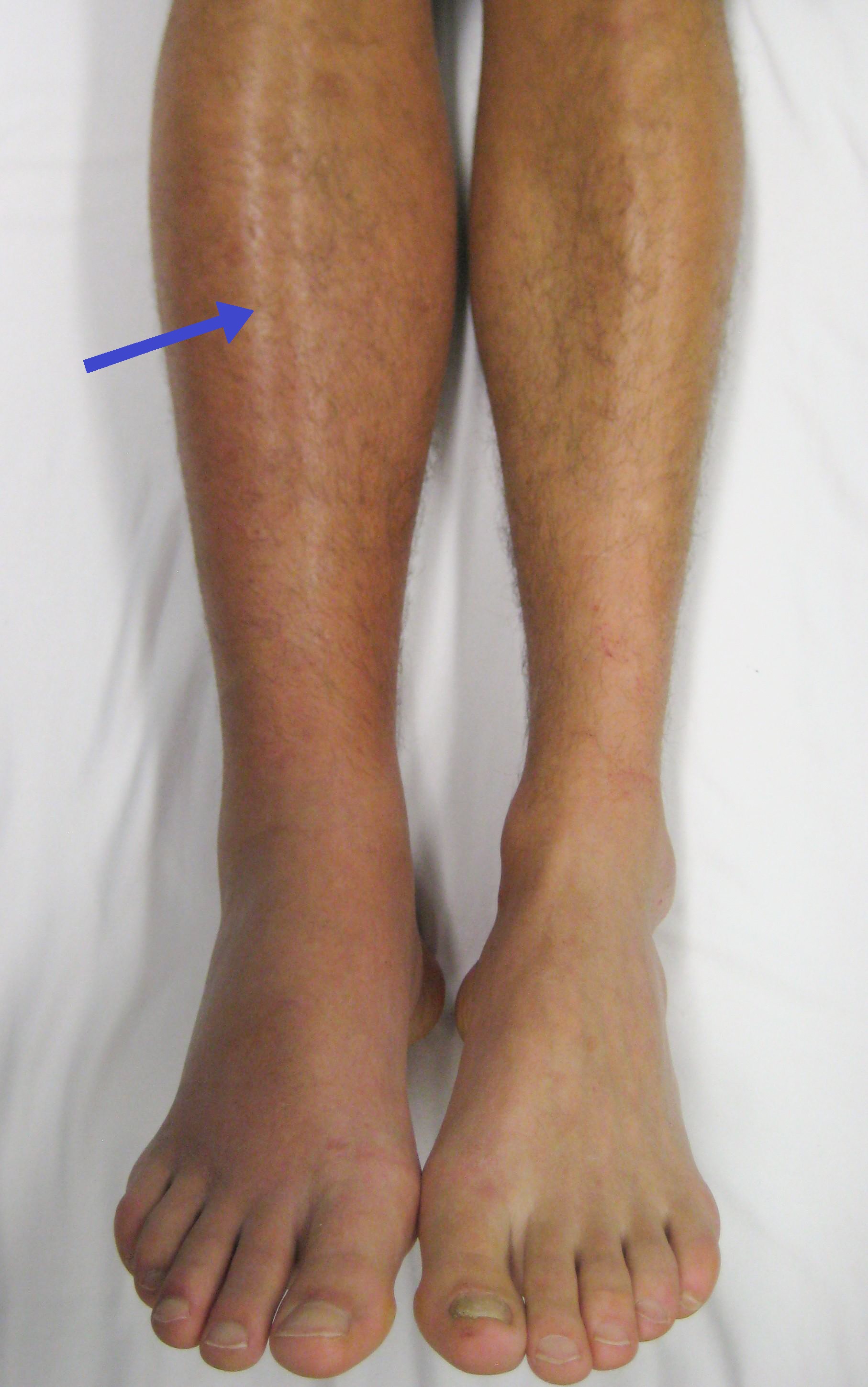
Dosage and Administration Guidelines
Simvastatin dosage ranges for cholesterol management
Typical starting doses range between 10-20 mg once daily, with titration based on lipid targets and clinical response.
Starting dose recommendations based on lipid profile and risk factors
Patients with severe hyperlipidemia may require higher initiation doses under medical supervision.
Max dose limits and safety considerations
The maximum recommended daily dose is 80 mg, though this is reserved for patients who have not achieved target goals with lower dosages.
Administration timing (evening dosing for optimal effect)
As cholesterol synthesis peaks overnight, Simcard is most effective when administered in the evening.
Dose adjustments for patients with renal or hepatic impairment
Lower dosages and careful monitoring are advised in patients with impaired renal or hepatic function.
Missed dose instructions
If a dose is missed, it should be taken as soon as remembered unless it is near the next scheduled dose. Doubling doses is not recommended.
Side Effects of Simvastatin
Common Side Effects
Common Side Effects
- Headache, dizziness, or unusual fatigue
- Gastrointestinal disturbances: nausea, abdominal discomfort, constipation
- Mild muscle pain or cramps
- Occasional sleep disturbances
- Simvastatin weight gain

Serious Side Effects
- Rhabdomyolysis and severe myopathy: rare but life-threatening muscle breakdown
- Elevated liver enzymes: may indicate hepatotoxicity
- Allergic responses: including skin rashes, swelling, or difficulty breathing
- Cognitive effects: rare reports of memory impairment or confusion
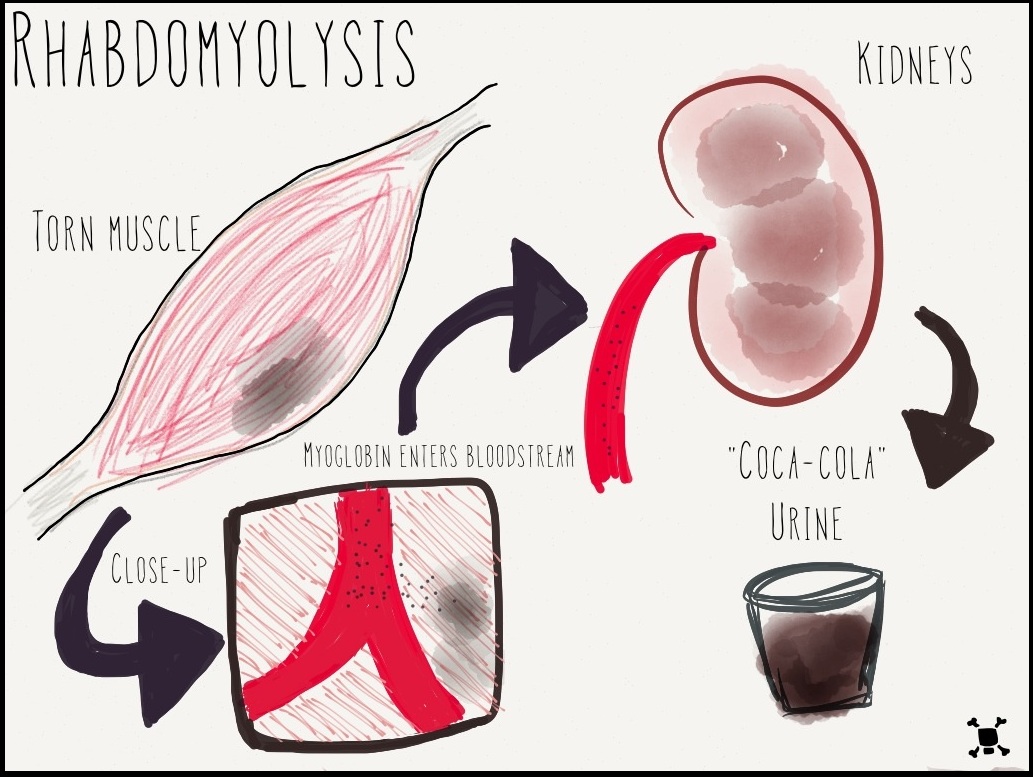
Simvastatin Side Effects in the elderly
Elderly patients are more likely to have age-related liver, kidney, heart, or muscle problems (eg, myopathy and rhabdomyolysis), which may require caution in patients receiving simvastatin.
Simvastatin Interactions
Interaction with CYP3A4 inhibitors (e.g., erythromycin, ketoconazole)
Simvastatin is metabolized primarily through the CYP3A4 enzymatic pathway. Concomitant use of potent inhibitors such as erythromycin, clarithromycin, ketoconazole, or itraconazole can dramatically increase plasma concentrations of the drug. This heightened exposure amplifies the risk of muscle-related toxicities, including myopathy and rhabdomyolysis.
Grapefruit juice and risk of toxicity
Grapefruit juice contains natural compounds that inhibit intestinal CYP3A4 activity. Even moderate consumption can elevate simvastatin levels, predisposing individuals to severe adverse events. Patients are strongly advised to avoid grapefruit products during therapy.

Interaction with other lipid-lowering drugs (fibrates, niacin)
- Fibrates (gemfibrozil, fenofibrate): synergistic lipid-lowering effects but increased myopathy risk.
- Niacin (nicotinic acid): when used at high doses, can lead to additive muscle toxicity.
Combination therapy should only be employed when benefits clearly outweigh risks, with close medical supervision.
Effects with anticoagulants and antiplatelet therapy
Simvastatin may modestly potentiate the effects of warfarin and other anticoagulants. Enhanced bleeding risk necessitates frequent monitoring of the International Normalized Ratio (INR) and clinical vigilance for hemorrhagic events.
Simvastatin and Alcohol
Concurrent alcohol intake can further strain hepatic function, particularly in patients with preexisting liver impairment. Limiting or abstaining from alcohol is advised to safeguard hepatic integrity during simvastatin therapy.

Warnings and Important Precautions
Risk of myopathy and rhabdomyolysis
Simvastatin carries a dose-dependent risk of muscle damage. While mild myalgia is relatively common, severe rhabdomyolysis can occur, leading to renal failure and life-threatening complications.

Monitoring of liver function tests before and during therapy
Baseline and periodic hepatic enzyme assessments are essential. Persistent elevations warrant dose reduction or discontinuation of therapy.
Risks associated with combining simvastatin with high-dose niacin
The co-administration of simvastatin with niacin doses above 1 g daily is associated with a substantial increase in myopathy risk. Such combinations should be used cautiously and only when strongly justified.
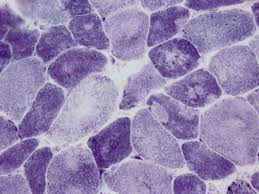
Precautions for patients with alcohol misuse or liver disease
Patients with a history of chronic alcohol use or hepatic pathology require stringent monitoring. Therapy may be contraindicated in cases of active or unexplained liver enzyme elevation.
Importance of reporting unexplained muscle pain or weakness
Early recognition of muscle-related symptoms is vital. Patients should immediately notify healthcare professionals if they experience unexplained muscle tenderness, weakness, or dark urine.
Simvastatin side effects after stopping
Stopping simvastatin does not lead to withdrawal symptoms; however, it greatly heightens your risk of a heart attack, stroke, or other severe cardiovascular events, as your cholesterol levels in the body are likely to increase once more.
Simvastatin alternatives
- Other Statins: Alternative statins such as rosuvastatin or atorvastatin function similarly but may be chosen based on individual requirements and possible side effects.
- Ezetimibe: This medication comes in tablet form and works by inhibiting cholesterol absorption from food within the intestine.
- PCSK9 Inhibitors: Injectable treatments (such as evolocumab or alirocumab) and the newer inclisiran act by blocking a protein that removes LDL ("bad") cholesterol receptors.
- Bile Acid Sequestrants: These medications attach to bile acids in the intestine, hindering their absorption and stimulating the liver to utilize more cholesterol from the bloodstream.
- Bempedoic Acid: This non-statin alternative aids in lowering LDL cholesterol and has a low risk of statin-related side effects like muscle symptoms.
Contraindications
- Hypersensitivity: contraindicated in patients with known allergy to simvastatin or any excipient.
- Active liver disease: or persistent, unexplained elevations of hepatic transaminases.
- Pregnancy and breastfeeding: contraindicated due to risks of fetal harm and excretion into breast milk.
- Concurrent potent CYP3A4 inhibitors: such as itraconazole, posaconazole, or protease inhibitors.
Careful Administration Guidelines
Administration to Elderly Patients
Elderly individuals face increased vulnerability to drug-drug interactions and myopathic complications. Lower initiation doses and gradual titration are recommended in frail or polypharmacy patients.

Administration to Pregnant Women and Nursing Mothers
- Simvastatin is contraindicated during pregnancy as it disrupts cholesterol synthesis essential for fetal development.
- Excretion into breast milk poses potential harm to infants; breastfeeding should be discontinued if treatment is required.
Administration to Children and Adolescents
Simvastatin has demonstrated efficacy in pediatric patients with familial hypercholesterolemia from the age of 10 years. Long-term use necessitates regular monitoring of growth, pubertal development, and biochemical markers of safety.
Overdosage and Emergency Management
Symptoms of simvastatin overdose
Overdose may result in exaggerated adverse effects, including profound muscle weakness, severe gastrointestinal disturbances, or elevated liver enzymes.
Supportive treatment and monitoring recommendations
There is no specific antidote. Management consists of supportive measures, careful monitoring of renal and hepatic function, and symptomatic treatment as necessary.
Storage and Handling Precautions
Recommended storage temperature and conditions
Simvastatin should be stored at controlled room temperature, generally between 20-25°C (68-77°F). Avoid extreme heat or freezing conditions.
Protecting tablets from moisture and light
Exposure to humidity and direct sunlight may degrade the stability of the active compound. Tablets should be stored in tightly sealed containers.
Safe handling and disposal guidelines
Unused or expired medication should be discarded according to local pharmaceutical disposal protocols, not in household waste or wastewater.
Keeping medication out of reach of children and pets
Simvastatin, like all prescription medicines, should be stored securely to prevent accidental ingestion by children or animals.
Simcard, Simvastatin FAQ
- What is simcard simvastatin used for?
- What is simvastatin used for?
- What is the use of simcard tablet?
- What should you avoid while taking simvastatin?
- What is the most serious side effect of simvastatin?
- How long should a person take simvastatin?
- Can simvastatin affect your kidneys?
- Is simvastatin a blood thinner?
- Can simvastatin cause weight gain?
- What vitamins cannot be taken with simvastatin?
- Can I drink coffee while taking statins?
- Does simvastatin affect sleep?
- What organ does simvastatin affect?
- Who cannot take simvastatin?
- How long is it safe to take simvastatin?
- Can simvastatin damage your kidneys?
- Does simvastatin make you pee more?
- Does simvastatin make you sleepy?
- Can simvastatin lower blood pressure?
- Is 20 mg of simvastatin a lot?
- Can simvastatin cause hair loss?
- What happens if I stop taking simvastatin?
- Does simvastatin clean arteries?
- What are the long-term side effects of simvastatin?
- Can simvastatin reduce belly fat?
- Can simvastatin cause joint pain?
- Can you take vitamin D with simvastatin?
- Why simvastatin before bed?
- How quickly does simvastatin lower cholesterol?
- What happens when you stop taking simvastatin?
- Can simvastatin make you tired?
What is simcard simvastatin used for?
Simvastatin is used to manage high cholesterol and lower the chances of heart attack and stroke. It functions by lowering bad cholesterol and fats (such as LDL and triglycerides) while boosting good cholesterol (HDL) in your bloodstream.
What is simvastatin used for?
Simvastatin is prescribed to reduce cholesterol levels if you have been diagnosed with high blood cholesterol. It is also used to help prevent heart disease, including heart attacks and strokes. This medication is part of a class of drugs known as statins.
What is the use of simcard tablet?
It helps reduce harmful cholesterol and fats, such as triglycerides, in your blood. It also aids in increasing beneficial cholesterol.
What should you avoid while taking simvastatin?
Avoid consuming excessive alcohol while taking simvastatin.
What is the most serious side effect of simvastatin?
- Severe muscle injury
- Liver issues
- Elevated blood glucose (sugar) levels.
How long should a person take simvastatin?
For life
Can simvastatin affect your kidneys?
Yes
Is simvastatin a blood thinner?
No
Can simvastatin cause weight gain?
Yes
What vitamins cannot be taken with simvastatin?
Niacin or nicotinamide
Can I drink coffee while taking statins?
No
Does simvastatin affect sleep?
Yes
What organ does simvastatin affect?
Liver
Who cannot take simvastatin?
- have liver or kidney issues.
- are attempting to conceive, are currently pregnant, or are nursing.
- have respiratory conditions.
- frequently consume excessive alcohol.
How long is it safe to take simvastatin?
For life
Can simvastatin damage your kidneys?
Statin use raises the risk of kidney damage, which may further deteriorate the condition of someone with kidney failure.
Does simvastatin make you pee more?
Yes
Does simvastatin make you sleepy?
Yes
Can simvastatin lower blood pressure?
Yes
Is 20 mg of simvastatin a lot?
No
Can simvastatin cause hair loss?
Simvastatin, a medication used to lower cholesterol, may lead to hair loss as a side effect, especially in older adults who have taken it for a long time.
What happens if I stop taking simvastatin?
Doing this raises the likelihood of heart-related health issues. This can involve chest pain, a heart attack, or even a stroke.
Does simvastatin clean arteries?
Yes
What are the long-term side effects of simvastatin?
- Muscle pain and injury.
- Liver injury.
- Elevated blood sugar or type 2 diabetes.
- Neurological effects.
Can simvastatin reduce belly fat?
No
Can simvastatin cause joint pain?
Yes
Can you take vitamin D with simvastatin?
Vitamin D might also reduce the likelihood of negative effects.
Why simvastatin before bed?
The body produces cholesterol at night, so simvastatin is effective at lowering cholesterol.
How quickly does simvastatin lower cholesterol?
4 weeks
What happens when you stop taking simvastatin?
If you discontinue your cholesterol medication, your cholesterol levels will elevate once more, which indicates a heightened risk of severe complications.
Can simvastatin make you tired?
Yes

